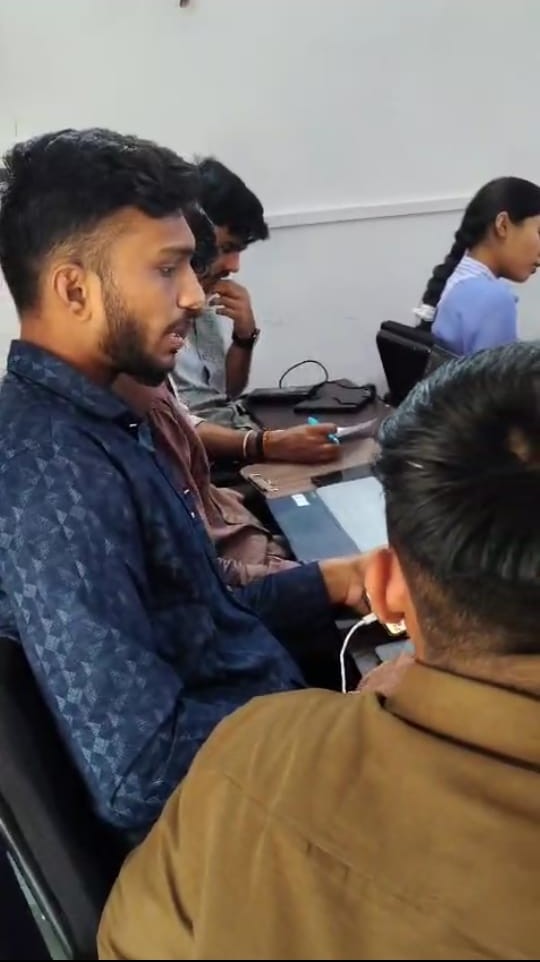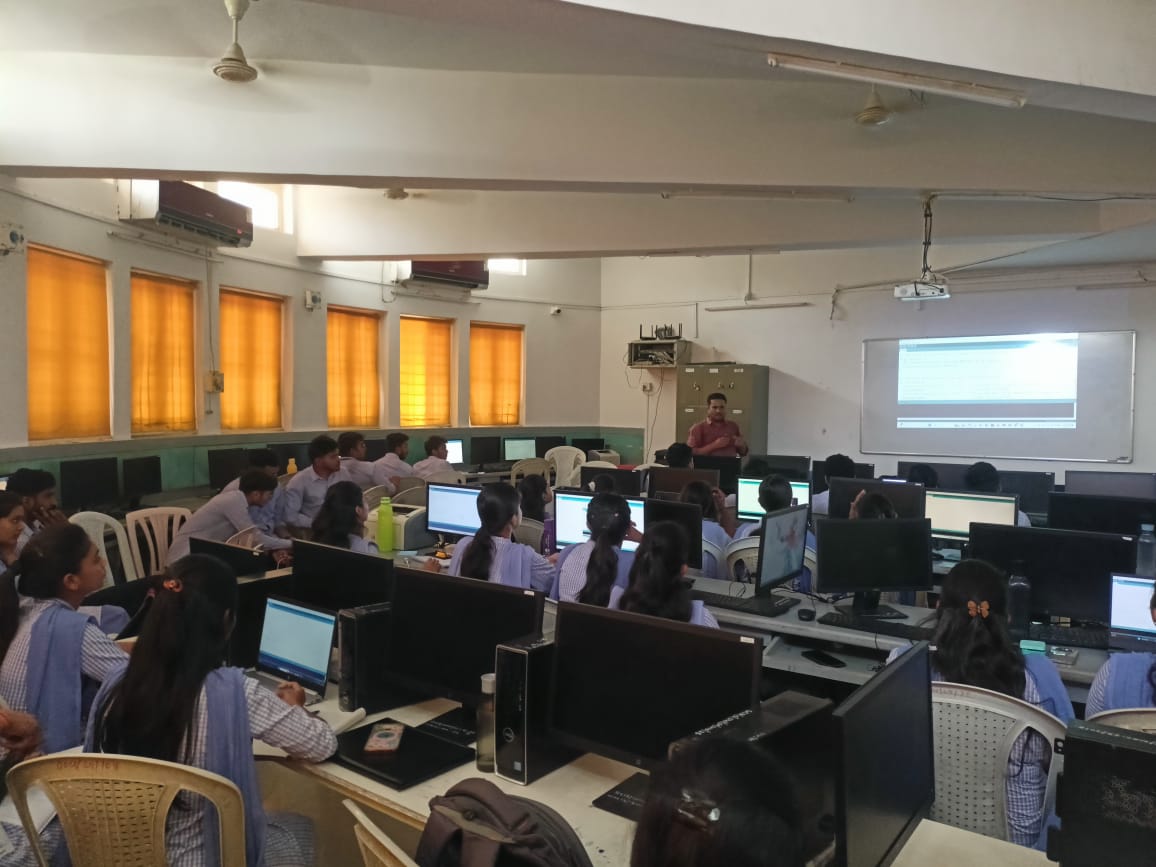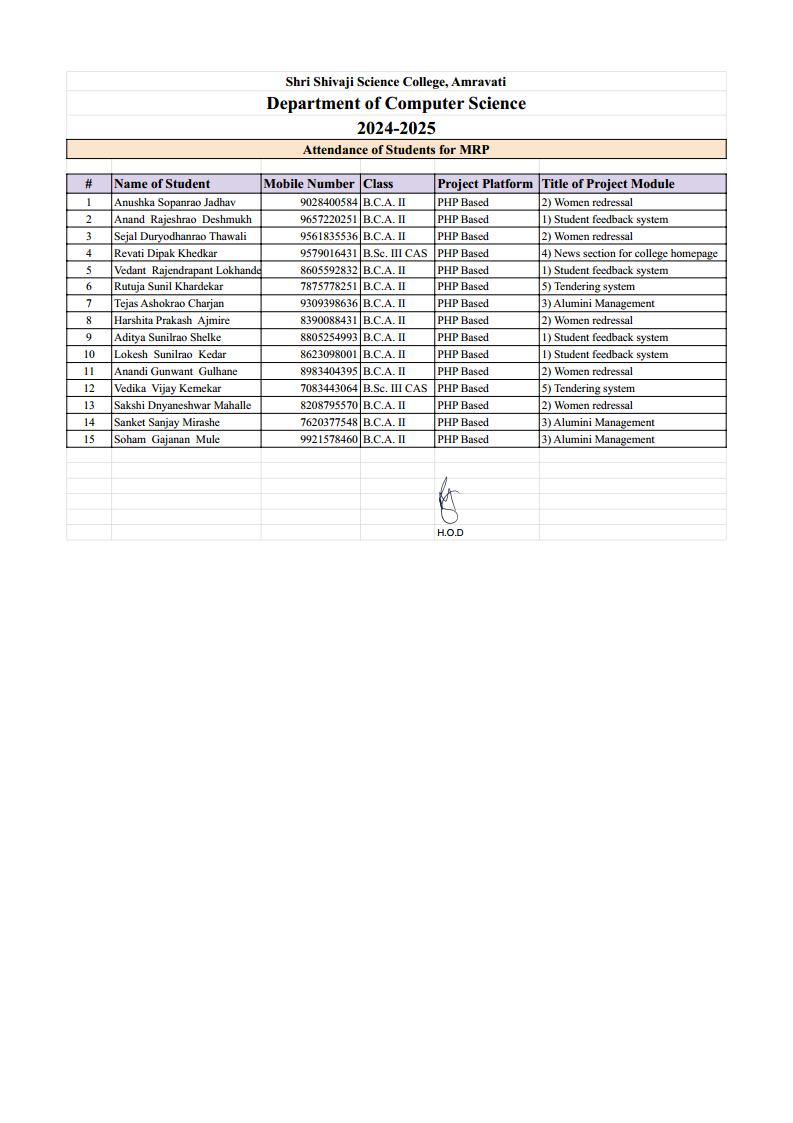SHRI SHIVAJI SCIENCE COLLEGE, AMRAVATI
DBT STAR COLLEGE PROJECT ACTIVITY
ACTIVITY REPORT

MRP-Web Applications for Institutes ~ Using PHP
Activity Dates: 15-30 April 2025
Type of Activity: Minor Research Project
Organizing Department: Department of Botany & Bioinformatics
Program Coordinators: Dr. U.S. Junghare, Mr. Y.V. Hushare
Head of the Department: Dr. M.M. Bhonde
External Collaborator (if any): Mr. Nakul Deshmukh, Director, iBase Solutions Pvt. Lt.
Objectives:
- Improving Teaching and Learning: By regularly collecting feedback from students, institutions can identify areas in which teaching methods and course content can be improved. It supports faculty in refining their instructional practices and aligning their approaches with students’ learning needs.
- Identifying Strengths and Weaknesses: The system helps in highlighting the strengths of faculty members while also pinpointing areas that require attention. This allows for targeted training, mentoring, and recognition of faculty performance.
- Promoting Continuous Improvement: Feedback results are compiled into comprehensive reports, offering administrators a clear view of institutional performance. These insights are vital for strategic planning and ongoing quality enhancement.
- Empowering Students: By giving student a voice in the evaluation process, the system fosters a sense of involvement and responsibility in their academic journey. Students feel valued when they know their opinions contribute to meaningful changes.
- Support for NAAC (National Assessment and Accreditation Council) Surveys: Many higher education institutions in India integrate feedback systems as part of their internal quality assurance mechanisms. Student feedback plays a critical role in NAAC accreditation, as it demonstrates institutional commitment to quality enhancement and stakeholder involvement.
No of Beneficieries: 25
Classes Involved: B.Sc. III CAS, B.C.A. II
Venue of the Activity: iBase Solutions Pvt. Ltd., Amravati
Activity Report:
Introduction:
In modern educational institutions, timely and effective feedback mechanisms are crucial for enhancing the quality of teaching and learning. The Student Feedback System is an online
platform designed to streamline the process of collecting and analyzing student feedback on faculty performance. This system enables students to provide feedback in an easy, fast, and
structured manner, ensuring their voices are heard and considered by the academic administration.
The main objective of this project is to facilitate transparent and efficient communication between students and college authorities. It replaces the traditional paper-based feedback process with a digital solution that is more accurate, accessible, and manageable. The system operates through a web-based interface, acting as a service provider that allows real-time interaction between students and the administration.
The Student Feedback System is divided into two main modules: Student and Admin. The Student module allows learners to log in and submit their feedback regarding their respective
faculty members based on predefined parameters such as subject knowledge, teaching methods, communication, and punctuality. The Admin module, typically managed by the principal or headof department, enables viewing and evaluating the submitted feedback in the form of comprehensive reports and grade summaries for each faculty member.
With this system, the principal can quickly assess teaching performance across departments and identify areas needing improvement. The feedback reports serve as a foundation for counseling
sessions and performance reviews, ultimately contributing to a better academic environment and enhanced teaching quality.
By implementing the Student Feedback System, colleges can ensure a more responsive, data-driven, and student-centric approach to faculty evaluation and institutional development.
What problem does it solve?
In many educational institutions, gathering student feedback on faculty performance and course delivery has traditionally been a manual, time-consuming process. These outdated methods often result in delayed or incomplete insights, making it difficult for administrators to respond to student concerns in a timely and effective manner. Additionally, the absence of a standardized system can lead to inconsistent data collection and analysis, limiting the institution’s ability to improve teaching quality and address students' academic needs efficiently.
The Student Feedback System addresses these issues by providing a structured, online platform for students to share their experiences and opinions. It allows educational institutions to collect
accurate and comprehensive feedback quickly and consistently. This system helps in identifying strengths and weaknesses in teaching, understanding student expectations, and fostering a
positive and inclusive learning environment. By enabling timely feedback, the system supports better decision-making and continuous improvement in academic delivery and staff performance.
Who is target audience?
The primary target audience for the Student Feedback System is the students of the institution. These are the individuals who actively participate in classroom learning and are best positioned
to evaluate the effectiveness of teaching methods, faculty engagement, and overall course delivery. By focusing on students as the core users, the system ensures that their voices are heard
and considered in institutional development.
Secondary users include administrators, department heads, and the principal, who utilize the collected feedback to assess faculty performance, make informed decisions, and implement
necessary improvements. Ultimately, this dual focus enhances the overall educational experience by bridging the gap between students and academic leadership through a transparent and
systematic feedback mechanism.
Abstract (Overview of the App)
The Student Feedback System is a web-based application developed to simplify and enhance the process of collecting, analyzing, and utilizing student feedback in educational institutions. It
serves as a digital platform where students can submit structured feedback regarding their academic experiences, faculty performance, and other aspects of institutional services. The
feedback collected through this system enables college administrations to make data-driven decisions that improve the quality of education and overall student satisfaction.
Student feedback forms are essential tools that help bridge the gap between students and educators. These forms are designed to capture insights into various dimensions of the learning
experience, including course content delivery, instructor effectiveness, classroom engagement, punctuality, and the use of teaching aids. By digitizing this process, the system ensures timely
feedback collection, minimizes administrative overhead, and increases the accuracy and reliability of the feedback data.
The core objectives of this application include:
• Improving Teaching and Learning: By regularly collecting feedback from students, institutions can identify areas in which teaching methods and course content can be
improved. It supports faculty in refining their instructional practices and aligning their approaches with students’ learning needs.
• Identifying Strengths and Weaknesses: The system helps in highlighting the strengths of faculty members while also pinpointing areas that require attention. This allows for
targeted training, mentoring, and recognition of faculty performance.
• Promoting Continuous Improvement: Feedback results are compiled into comprehensive reports, offering administrators a clear view of institutional performance.
These insights are vital for strategic planning and ongoing quality enhancement.
• Empowering Students: By giving student a voice in the evaluation process, the system fosters a sense of involvement and responsibility in their academic journey. Students feel
valued when they know their opinions contribute to meaningful changes.
• Support for NAAC (National Assessment and Accreditation Council) Surveys: Many higher education institutions in India integrate feedback systems as part of their
internal quality assurance mechanisms. Student feedback plays a critical role in NAAC accreditation, as it demonstrates institutional commitment to quality enhancement and
stakeholder involvement.
Working module:
The Working Module of the Student Feedback System outlines how the system operates to collect, manage, and utilize student feedback in a streamlined and efficient manner. It serves as
the core functionality of the application, enabling interaction between students and administrators through a user-friendly web interface.
In this module, students are provided with secure login access, allowing them to submit feedback on various aspects of their academic experience, including teaching effectiveness, course content, clarity of instruction, punctuality, and interaction levels. The feedback is typically collected through a structured questionnaire, using a grading or rating system that ensures consistency and comparability across different faculty members and subjects. Once submitted, the feedback is securely stored in the system’s database, where it becomes
accessible to authorized administrators such as department heads or the principal. The admin module includes tools for analyzing the feedback, generating reports, and identifying patterns or
trends. These reports provide valuable insights into the strengths and weaknesses of faculty members and help in taking informed actions such as performance reviews, training sessions, or
counseling.
Overall, the working module ensures a closed feedback loop—where feedback is not only collected but also acted upon—supporting continuous improvement in teaching quality and
student satisfaction.
Technologies Used:
Front-End Technologies:
• HTML: Used to create the structure and layout of the web pages, ensuring proper
content organization.
• CSS: Applied to style the website and enhance its visual presentation with colors, fonts,
and spacing.
• Bootstrap: A front-end framework used to build responsive and mobile-friendly
interfaces quickly.
Back-End Technologies:
• PHP: A server-side scripting language used to handle logic, interact with the database,
and process user inputs dynamically.
Database:
• MySQL: A relational database system used to securely store and manage user
information, feedback, complaints, and administrative records.
Web Server:
• Apache: An open-source web server software used to host and serve PHP-based
applications on the internet.
Outcomes:
- Design and Deployment of Modular Web Applications Students successfully designed and developed five independent yet integrable web modules using PHP and MySQL, demonstrating practical application of web programming concepts.
- Improved Feedback and Grievance Redressal Mechanisms The Student Feedback System and Women Grievance Redressal System were implemented to collect, store, and process feedback and complaints securely, promoting transparency and institutional accountability.
- Enhanced Alumni Engagement Creation of the Alumni Management module enabled collection and management of alumni data, facilitating better alumni relations, networking, and institutional development activities.
- Real-Time Information Sharing A dynamic News Section was developed for the college homepage to publish updates, notices, and events efficiently, improving communication between the institute and stakeholders.
- Streamlined Tender Management The Tendering System provided a digital platform to publish tenders and manage bid submissions, supporting fair and paperless procurement processes.
Photos:
 Active participation of students in MRP on PHP based 4 |  Active participation of students in MRP on PHP based 2 |
 Active participation of students in MRP on PHP based project 2 |  Active participation of students in MRP on PHP based project 3 |
 Active participation of students in MRP on PHP based project 4 |  Active participation of students in MRP on PHP based project 5 |
Attendance Sheet:
 |